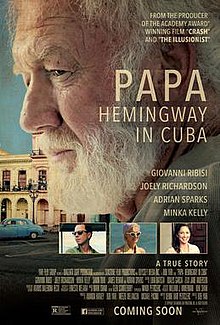
by Peter J. O’Connell
PAPA: Hemingway in
Cuba. Released: April 2016. Runtime: 110 mins. MPAA rating: R for language,
sexuality, some violence and nudity.
PAPA: Hemingway in
Cuba, written by Denne Bart Petitclerc and directed by Bob Yari, begins
with Ed Myers at age 5 in the Depression, abandoned by his father and soon
after placed in an orphanage by his mother. The movie then takes us to Miami in
the late 1950s.
After a knockabout life, Ed (Giovanni Ribisi), has become a
journalist. He tells his girlfriend (Minka Kelly) that his love of the writings
of Ernest Hemingway is responsible for his achieving a career. Copying out all
of the stories of Hemingway taught him how to write well.
Ed informs his girlfriend that he has, in fact, written a
letter to Hemingway, who has been living in Cuba, thanking the great author.
Ed, however, does not have the nerve to mail the letter, but his girlfriend
sends it surreptitiously anyway. Ed is stunned when he receives a letter back
from Hemingway inviting him to come to Cuba for a fishing trip.
Ed, with some trepidation, flies to Cuba and goes fishing
with the bearded, sixtyish Hemingway (Adrian Sparks), now called “Papa” by many
of his friends. The two bond, and Ed becomes a regular at Hemingway’s Finca
Vigia estate, where Papa lives with his wife, Mary (Joely Richardson), and
presides over dinners and parties with chums from Spanish Civil War and World
War II days and other friends (including one played by Ernest Hemingway’s
actual granddaughter Mariel).
Ed is starstruck as Papa Hemingway becomes his mentor,
almost, in fact, a surrogate father. But as time goes on, Ed comes to realize
that his idol has feet of, well, flesh and blood. The great man, who witnessed
wars close up and was in prize fights and bar fights and battled wild beasts
and huge fish is now in a battle with alcoholism, depression, paranoia and
writer’s bloc, a battle that he seems to be losing. And Papa is taking out his
despair on his loving wife, Mary, to the distress of Ed.
As the personal drama at Finca Vigia intensifies, dramatic
events taking place elsewhere in Cuba start to enter the picture. Castroite
rebels are making gains against the repressive Batista regime. The movie
concludes as a kind of political thriller when, in scenes of dubious
historicity, Hemingway and Ed aid the rebels.
PAPA: Hemingway in
Cuba is based on events from the life of its writer, Denne Bart Petitclerc
(1929-2006), the model for the character Ed Myers in the film. Petitclerc
became a successful writer and producer for films and TV series and wrote the
movie version (1974) of Hemingway’s posthumously published (1970) novel Islands in the Stream. Before his death
Petitclerc wrote the screenplay for PAPA:
Hemingway in Cuba. Petitclerc lived for 35 years in Ketchum, Idaho, where
Hemingway committed suicide in 1961.
Giovanni Ribisi’s portrayal of Ed Myers is adequate, no
more. Minka Kelly as Ed’s girlfriend brings little except gorgeous looks to
what is essentially a superfluous role. Joely Richardson, of the famed
Redgrave/Richardson clan, is strong as Mary Hemingway. The alpha actor of the
drama, however, is Adrian Sparks.
Sparks’ Hemingway is of Shakespearean proportions, a kind of
Lear-like literary lion fighting real and imagined enemies. It is a towering
performance, perhaps never more so than when Hemingway is at his lowest
points—entering zero after zero on a listing of words written each day or
gazing longingly at a gun in his hand. The actor also bears a striking physical
resemblance to the author whom he plays.
PAPA: Hemingway in
Cuba is the first American feature film to be made in Cuba since 1959, and
director Yari makes good use of such actual locations of Papa’s life as Finca
Vigia and the bar of the La Floridita hotel, where one night Hemingway drank 17
cocktails in succession.
I'd paid no attention to this film until your review. Now I'll seek it out.
ReplyDelete